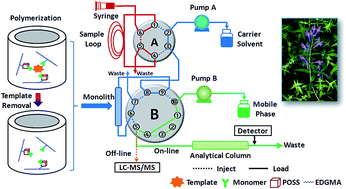Preparation of a POSS-hybridized molecularly imprinted monolith for the analysis of baicalin and its analogues in a microwave-assisted extract from Scutellaria baicalensis by means of on-line SPME-HPLC and off-line LC-MS/MS†
Abstract
Molecularly imprinted polymers (MIPs) have been attracting increasing attention and used in various applications due to their tailor-made and adjustable selectivity. By means of innovation of the imprinting methods, such as using winnowing templates based on the analytical targets, the selectivity of MIPs can either be narrowed down to one particular molecule (high specificity), or broadened up to one group of analogues (wide selectivity). Based on the recent finding that polyhedral oligomeric silsesquioxanes (POSS) can enhance the absorption capacity of separation media, a baicalin-imprinted POSS hybridized monolith was synthesized and systematically investigated in terms of the preparation conditions and running parameters when using the MIP monolith as a capture column in on-line in-tube SPME-HPLC. The resulting MIP could be utilized to enrich baicalin out of a complex matrix of Scutellaria baicalensis for facile quantitative analysis. Furthermore, by means of off-line LC-MS/MS, wide selectivity for capturing analogues of baicalin was also qualitatively confirmed. This work provides a new perspective and method for controlling the wide selectivity of MIPs, and also a facile 2-dimensional HPLC system for the analysis of traditional Chinese medicine (TCM).



 Please wait while we load your content...
Please wait while we load your content...